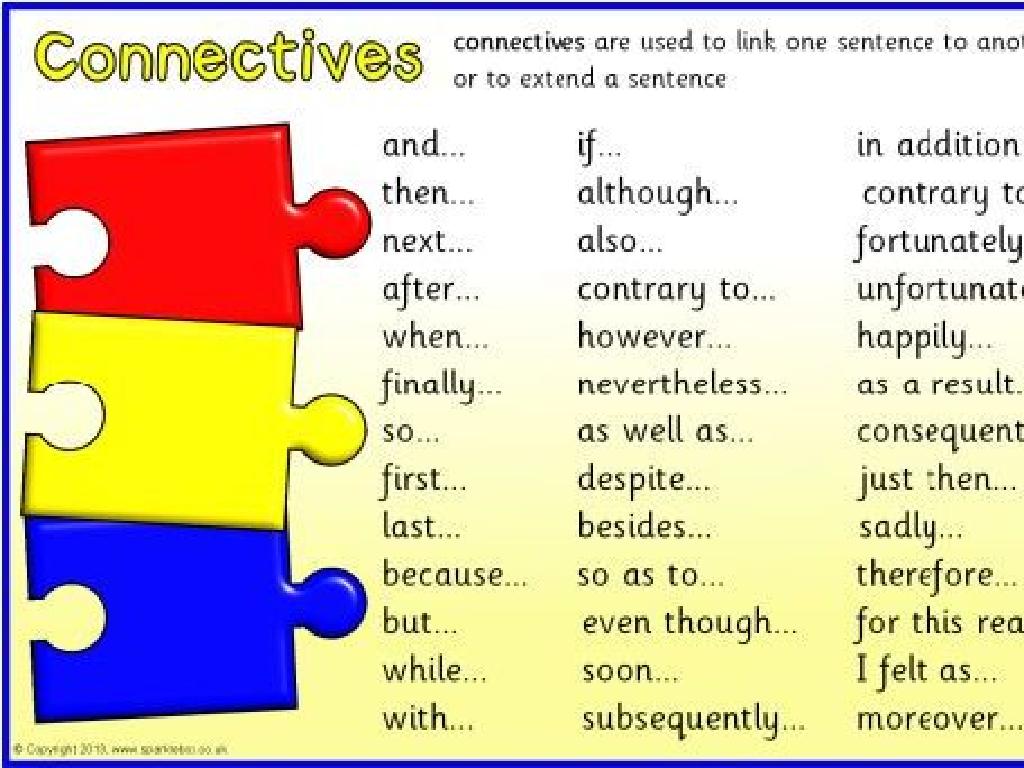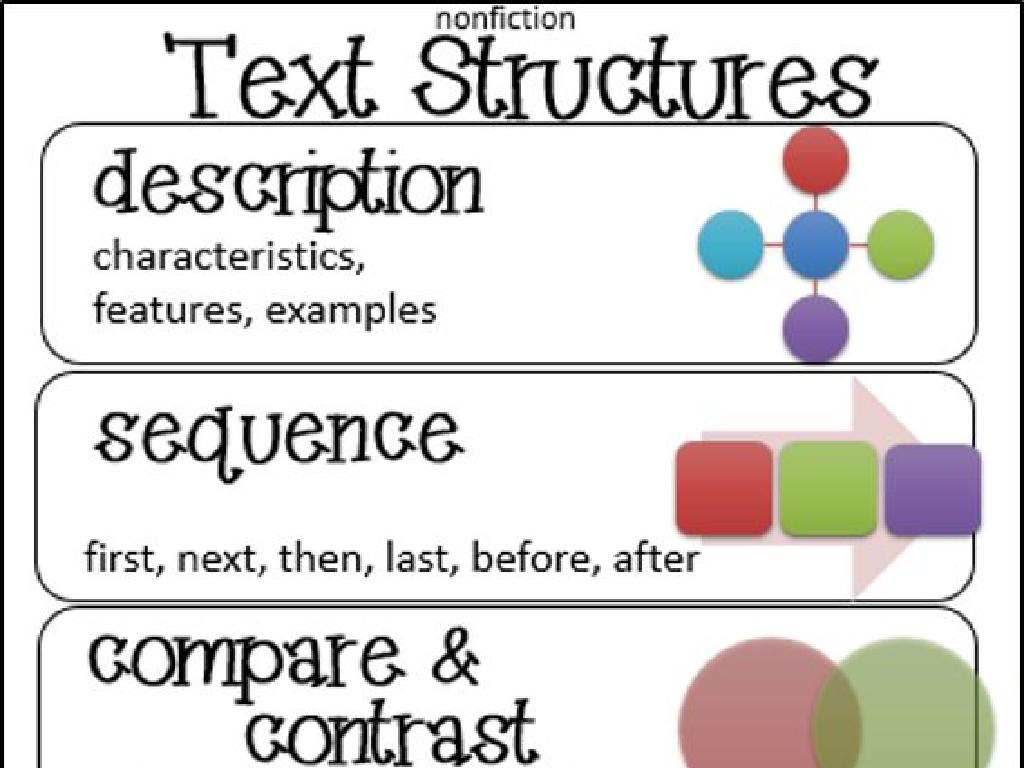Comparison Word Problems Up To 10: How Many More Or Fewer?
Subject: Math
Grade: First grade
Topic: Comparison Word Problems Up To 10
Please LOG IN to download the presentation. Access is available to registered users only.
View More Content
Becoming a Comparison Wizard!
– Learn to compare numbers
– Grasp ‘more’ and ‘fewer’
– ‘More’ means a greater number, ‘fewer’ means a smaller number
– Solve comparison problems
– Use objects like apples to see which group has more or fewer
– Practice with fun activities
|
This slide introduces first graders to the concept of comparing numbers with a focus on understanding the terms ‘more’ and ‘fewer’. Start by explaining that comparing numbers helps us see which group has a larger or smaller amount. Use relatable examples, such as comparing groups of fruits or toys, to illustrate the concept. Introduce simple word problems that use ‘more’ and ‘fewer’ to describe the comparison. Engage the students with hands-on activities where they can physically group and compare items, reinforcing the concept. Encourage them to articulate their thought process as they determine which group has more or fewer items. This will help build a strong foundation for solving comparison word problems.
Understanding ‘More’ in Math
– ‘More’ means a larger number
– When comparing, ‘more’ indicates a bigger quantity
– Count to see which is more
– We’ll practice counting items in two groups to compare
– Example: 5 is more than 3
– If you have 5 apples and I have 3, you have more apples
|
This slide introduces the concept of ‘more’ to first graders, which is a foundational comparison skill in mathematics. Start by explaining that ‘more’ indicates a greater amount or number. Use visual aids like pictures of apples to illustrate the concept. Have the students practice by counting items in two groups to determine which has more. Use simple, relatable examples to ensure understanding. Encourage students to use their fingers to count and to visualize the concept of ‘more’ with objects they are familiar with. Reinforce the concept by asking questions like ‘Who has more crayons?’ or ‘Which line is longer?’ to make the learning interactive and engaging.
Understanding ‘Fewer’ in Word Problems
– ‘Fewer’ means a smaller number
– Fewer is used when comparing two amounts
– Count to find which has fewer
– Let’s count items in two groups to see which has less
– Example: 2 is fewer than 4
– If you have 2 pencils and I have 4, you have fewer pencils
|
This slide introduces the concept of ‘fewer’ to first graders, which is a fundamental term used in comparison word problems. Start by explaining that ‘fewer’ indicates a smaller amount or number when comparing two sets of items. Use tangible examples like pencils, as they are relatable to students. Have the students practice by counting items in two groups to determine which group has fewer items. Encourage them to use the word ‘fewer’ in sentences to describe their observations. For example, ‘I have fewer candies than my friend.’ This will help solidify their understanding of comparison in a practical context.
Let’s Compare Numbers!
– Comparing shows differences
– See how two numbers are not the same
– Count using fingers
– Use fingers to count up or down
– Practice with toy comparisons
– How many more toy cars than dolls?
– Understand ‘more’ and ‘fewer’
– ‘More’ means a bigger number, ‘fewer’ means a smaller number
|
This slide introduces the concept of comparison in mathematics to first graders. Start by explaining that comparing is a way to see how things are different, especially in quantity. Demonstrate how to use fingers to count and compare numbers, which is a practical and visual method for young learners. Engage the class with an interactive activity where they compare groups of toys, such as toy cars and dolls, to identify which group has more or fewer items. Reinforce the vocabulary ‘more’ and ‘fewer’ with examples, and ensure that students can use these terms correctly in the context of comparison. Encourage participation and assist students who may have difficulty with the concept.
Word Problems: Who Has More Balloons?
– Counting my balloons
– I have 4 balloons in total.
– Counting my friend’s balloons
– My friend has a total of 6 balloons.
– Comparing to find who has more
– Does 4 or 6 have a higher count?
– Calculating the difference
– Subtract 4 from 6 to find out how many more.
|
This slide introduces students to comparison word problems focusing on ‘how many more’. Start by reading the problem aloud and then visually counting the number of balloons each person has. Guide the students to compare the two quantities to determine who has more. Use manipulatives like actual balloons or counters to help them visualize the problem. After identifying who has more, teach them to find the difference by subtracting the smaller number from the larger number. This exercise will help students understand the concept of comparison and develop their subtraction skills.
Word Problems: Which Has Fewer?
– Count birds in the first tree
– There are 3 birds in the first tree.
– Count birds in the second tree
– There are 5 birds in the second tree.
– Compare to find which has fewer
– Tree with 3 birds has fewer than tree with 5.
– Use pictures to visualize
– Drawing helps us see the difference clearly.
|
This slide is aimed at helping first graders understand comparison word problems by using visual aids. Start by showing pictures of two trees with different numbers of birds. Guide the students to count the birds in each tree and then compare the numbers to determine which tree has fewer birds. Emphasize the concept of ‘fewer’ by explaining that it means a smaller number or amount. Encourage the students to draw their own pictures to solve similar problems, reinforcing the concept through visual learning. This hands-on approach will help them grasp the idea of comparison in a concrete way.
Class Activity: More or Fewer with Blocks!
– Let’s play a block game!
– Make two piles of blocks
– Which pile has more or fewer?
– Solve problems with a partner
– Create your own word problems about the block piles and find out who has more or fewer blocks.
|
This interactive class activity is designed to help first graders understand the concept of comparison by using tangible objects like blocks. Students will engage in a hands-on learning experience by creating two distinct piles of blocks with their partner. They will then practice comparing the two piles to determine which has more or fewer blocks. Encourage them to articulate their thought process and use mathematical language. Provide guidance on how to create simple word problems based on their block piles. For example, ‘I have 7 blocks, and my partner has 5 blocks. How many more blocks do I have?’ or ‘My partner has 3 fewer blocks than I do. How many does my partner have if I have 8?’ This activity fosters collaboration and critical thinking as students work together to solve problems.
Review: More or Fewer in Word Problems
– Understanding ‘more’ in problems
– ‘More’ means a larger number or amount
– Explaining the meaning of ‘fewer’
– ‘Fewer’ means a smaller number or amount
– Sharing our discoveries
– Discuss examples and solutions from class
|
This slide is aimed at reviewing the key concepts of comparison in word problems, focusing on the terms ‘more’ and ‘fewer’. Begin by asking students to recall what they’ve learned about the word ‘more’ and how it indicates a greater quantity. Then, discuss ‘fewer’ as the opposite, signifying a lesser quantity. Encourage students to share their discoveries and examples from the day’s lesson, reinforcing their understanding through repetition and peer learning. This review will solidify their grasp of comparison word problems and prepare them for more complex mathematical concepts.
Great Job on Comparison Word Problems!
– Celebrate learning about more & fewer
– Homework: Find items to compare
– Use toys, fruits, or books to compare quantities
– Remember: Practice is key
– Share your comparisons next class
– Think about what has more or fewer and by how much
|
This slide wraps up the lesson on comparison word problems and sets up the homework assignment. Encourage the students to find objects at home like toys, fruits, or books and compare their quantities using the concepts of ‘more’ and ‘fewer’. Remind them that practicing these comparisons will help solidify their understanding. In the next class, be prepared to have students share their findings, which will reinforce their learning and allow them to demonstrate their understanding of the concept.






